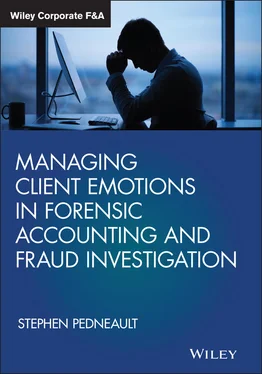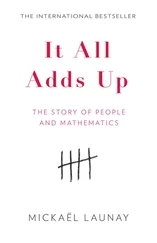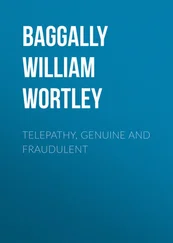I set up a time to meet at the attorney's office to review the records and information he had been able to collect, as well as to meet his clients. The attorney ended our conversation by warning me that the sister was very emotional and her brother had a serious drinking problem and could become hostile.
When the day of our meeting arrived, I drove to the attorney's office with one of my staff members. We were greeted at the door and brought into an empty office where the attorney met with us privately prior to introducing us to his clients. He said he had been meeting with the sister and brother for an hour or so and that the brother had become quite agitated toward the trustee. The attorney warned us again that the brother could be a bit of a loose cannon.
Next, the attorney brought us into his conference room, where the sister and brother were sitting at the table. The sister, a well‐dressed, mild‐looking woman with a petite frame, sat next her brother, a middle‐aged man dressed in jeans, a flannel button‐down shirt, and sneakers. She was sitting upright and attentive, with papers neatly stacked in front of her, while he was slouched back in his chair at a 45‐degree angle. The attorney introduced us to the siblings, and we started the meeting.
The attorney provided his rendition of what had happened from the time the siblings’ mother had died to the present, identifying the difficulties he had encountered in obtaining information and answers for his clients. As part of his story, the attorney noted that the mother was divorced from his clients’ father, who had since died, and that she had remarried a man named Tim. That made Tim his clients’ stepfather, although his clients were well into their fifties when their mother remarried.
Sometime between the mother's marriage to Tim and her death, their mother had redone her estate planning, changing the terms, beneficiaries, and distributions, which had previously been a simple estate left solely to her son and daughter. The new estate planning designated all of the mother's assets to be transferred into a trust for the benefit of her son and daughter. The mother named her accountant as the independent trustee over her trust and provided him with broad authority over the management and use of her trust's assets until Tim's death. Upon Tim's death, the trustee was to distribute the remaining trust assets to the son and daughter.
The trust provided two additional provisions. First, during Tim's lifetime, the trustee was to distribute a specified amount each calendar year to the son and daughter. Second, the trustee was to allow Tim the exclusive use of the mother's residence until his death, with the provision that the trustee had the right to inspect the property at any time, provided he gave Tim advance notice of the inspection.
So far, the scenario the attorney described was similar to many we had seen in previous matters, and we predicted that the story would identify a difficult trustee and clashes between the brother, the sister, the trustee, and Tim.
The trustee, who was retirement‐aged, was a certified public accountant (CPA), as was his son, who was 20 years his junior. The son was also an independent investment manager, and his father chose to utilize his son to manage the trust's investments. The clients’ attorney said he had requested statements from both the father and the son regarding the trust assets and investments, but to date neither had produced any information.
The clients’ attorney stated that Tim had been living in the mother's house prior to her death and had continued living there even after she became sick and relocated to a nursing home. Tim still lived in the house, and the brother and sister had heard through neighbors that Tim had let the house and yard become run down. Tim was dealing with significant health issues, and it was uncertain how long he would live.
When the attorney finally ended his story, he allowed his clients to speak for the first time since the meeting had started.
The sister spoke first, thanking us for meeting today. She took out her notebook and read through her notes and timeline as she added more detail to the attorney's story. The sister said she'd had a very close relationship with her mother up until the time her mother met Tim. Once Tim came into the picture, however, their relationship became strained, and it did not return to its former closeness until the last days of her mother's life. She said that her mother had been physically and emotionally abused by Tim and had twice been treated at the hospital for injuries Tim inflicted. However, her mother would not leave Tim and returned to him after each incidence of violence. The sister stated that, even when her mother had cancer, Tim continued to abuse and neglect her. The last time her mother had been hospitalized, she had appeared malnourished. The sister said that her mother had told her that she was afraid of Tim and that she did not want to go home.
During her account, the sister's face turned red and her eyes puffy. Tears streamed down her face.
The sister said that Tim had come to the nursing home and created a scene, which led to her obtaining a restraining order to keep Tim away from her mother. Even as her mother lay in bed dying at the nursing home, her mother feared Tim would come there, and thus she never relaxed. Her mother told her that she was so sorry Tim had interfered with her and her daughter's prior relationship. The mother felt that the last few years of her life had been her worst, as she had suffered abuse, neglect, illness, and separation from her children. The sister had not known how bad things were between her mother and Tim, and it broke her heart to sit talking with her dying mother, knowing she couldn't fix the past and had little to no time left to make her mother happy again.
After this disclosure, the sister broke down and cried, but received no comfort from her brother. After a few minutes, the sister apologized for crying and described how angry she was with Tim and the trustee, whom she described as working with Tim to take the estate and trust funds for themselves. Her face tightened, and her fists clenched. She said that both Tim and the trustee were crooks, as was the trustee's investor son, and that she wanted them all removed from anything to do with her mother's estate and trust. She wanted them all locked up in prison. She wished Tim was dead because of what he had done to her mother. Every day that Tim lived in her mother's house and the trustee continued to handle the funds, she said, more and more money would be improperly spent or stolen by them, leaving less for her brother and herself.
Then, the sister turned to her brother and asked if he wanted to add anything to the story. The brother's face tensed, and he also clenched his fists. He rapidly shifted from slouching to sitting upright in his chair. The brother shouted that Tim should be dead for what he'd done to his mother and for what he continued to do, living at his mother's house, which rightfully belonged to them. He said that he had gone to the house on a few occasions and recognized that Tim was nothing but a drunk. Tim was overweight, poorly dressed, and in poor health. The house and yard were in a state of major disrepair, even though there was evidence the trustee had paid funds to maintain the house.
The brother was clearly angry, his face bright red. He said that if Tim were to die, the trustee could be ordered to close out the estate and trust, and he and his sister could go on with their lives and find closure after their mother's death. He said he did not have a permanent address or mailing address and that he lived for long periods of time in remote areas where mail was not important. He was leaving for the mountains of Maine right after our meeting, and we might never see him again. He might connect with his sister so she knew where to reach him, mainly to know when the trust distributions were available. If he had the option, he would handle Tim, the trustee, and the trustee's son his way. That way, he could get closure for his sister, who could then move on with her life and not have to deal with Tim or the trustee in the future.
Читать дальше












